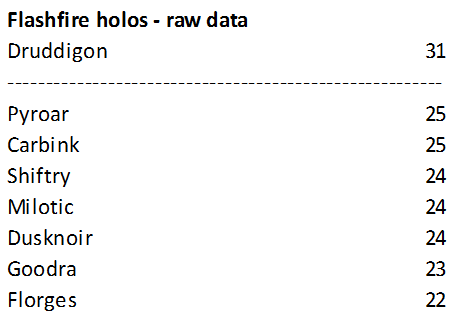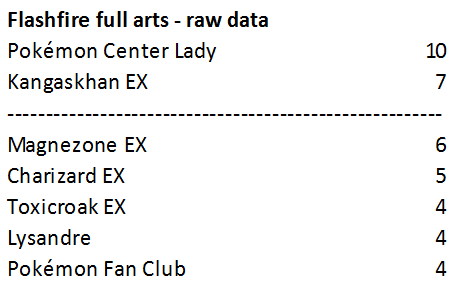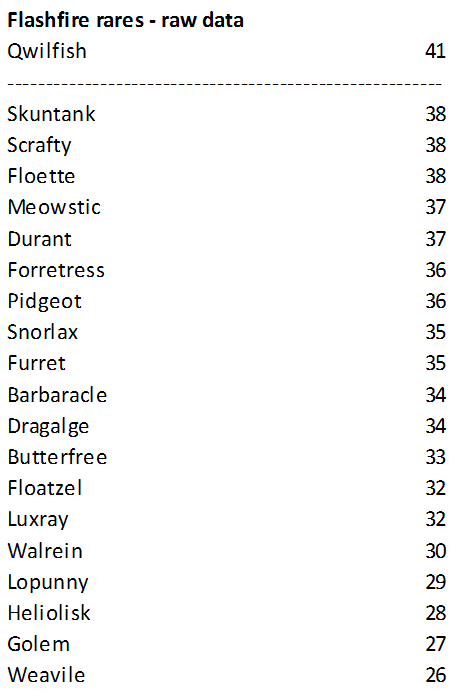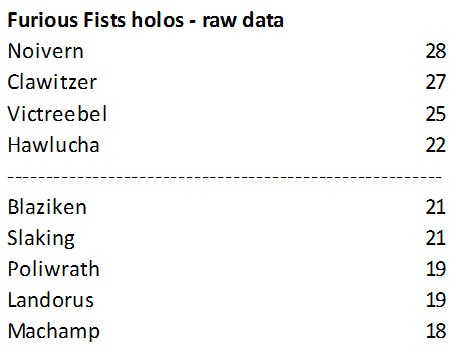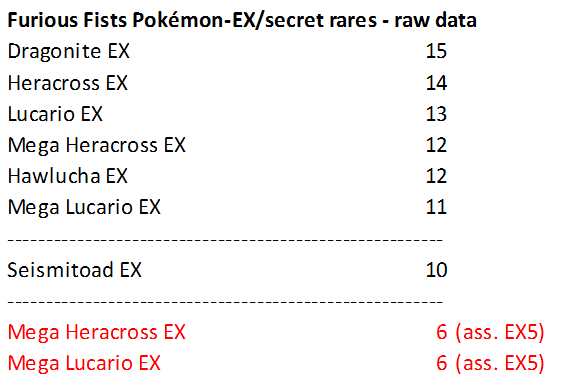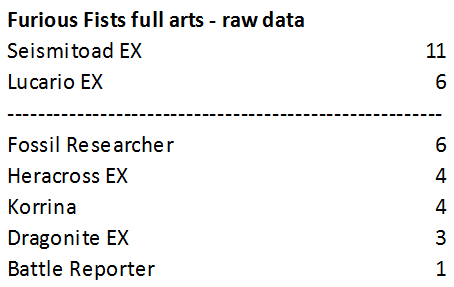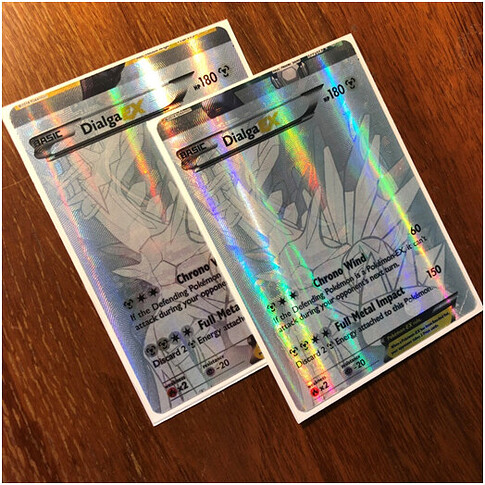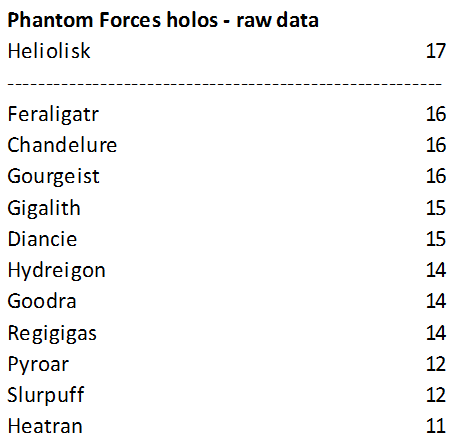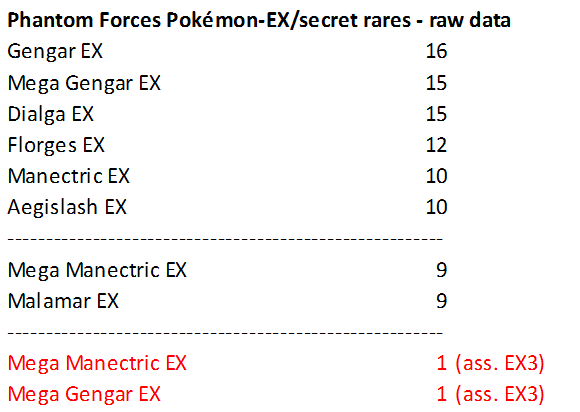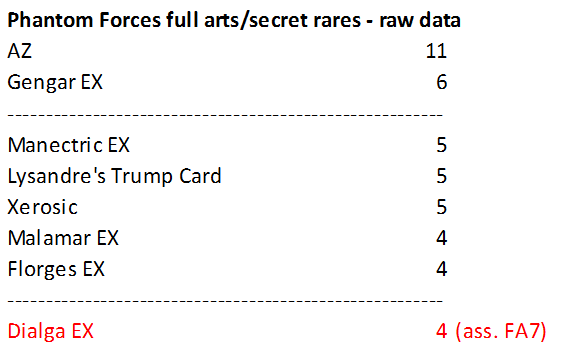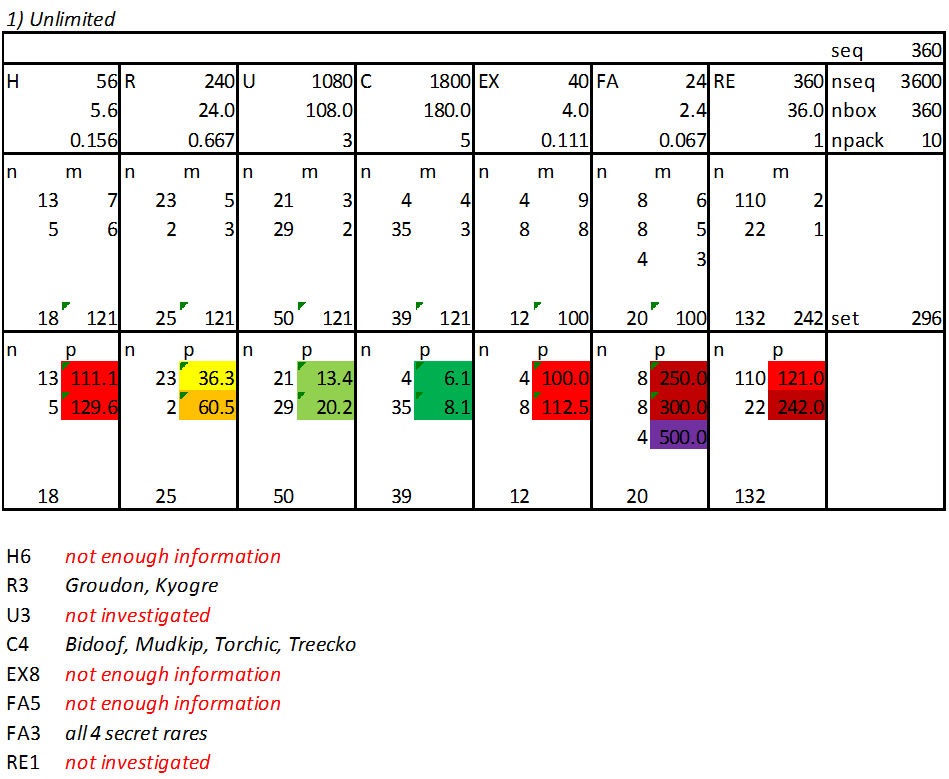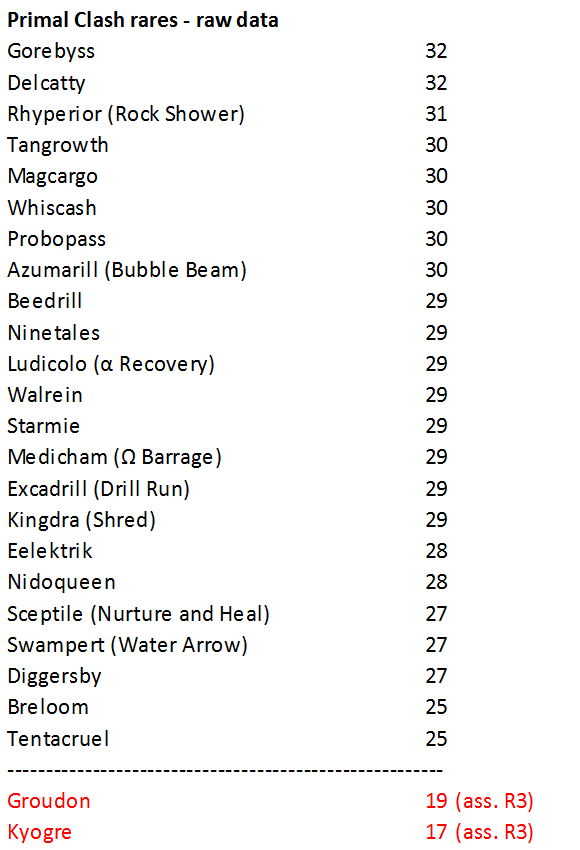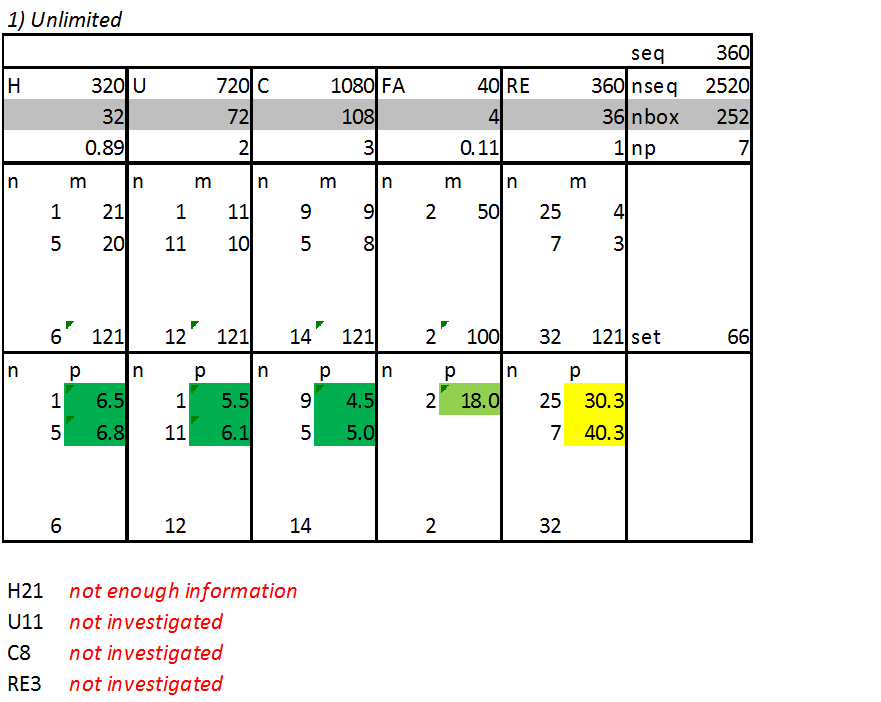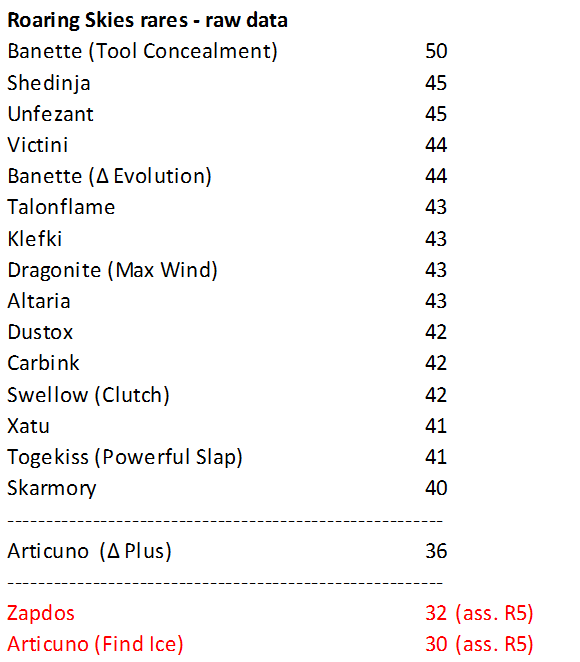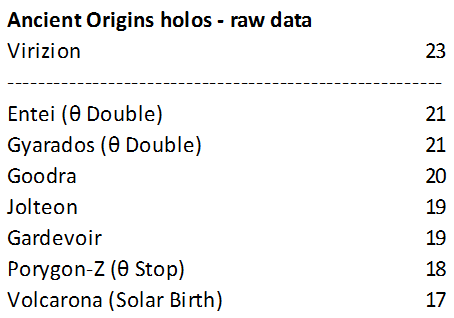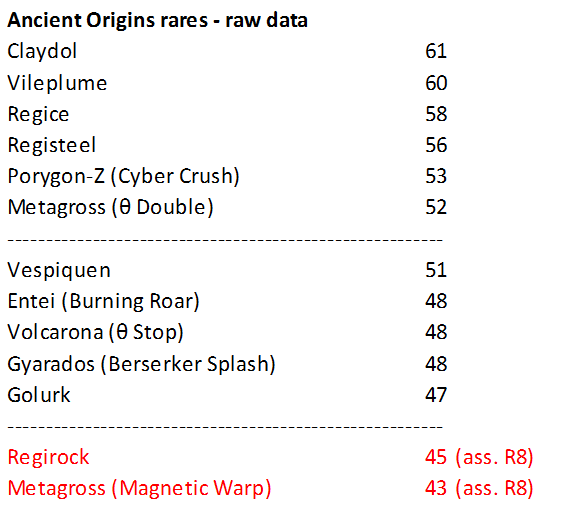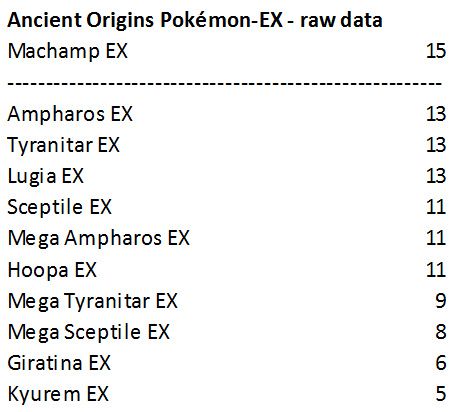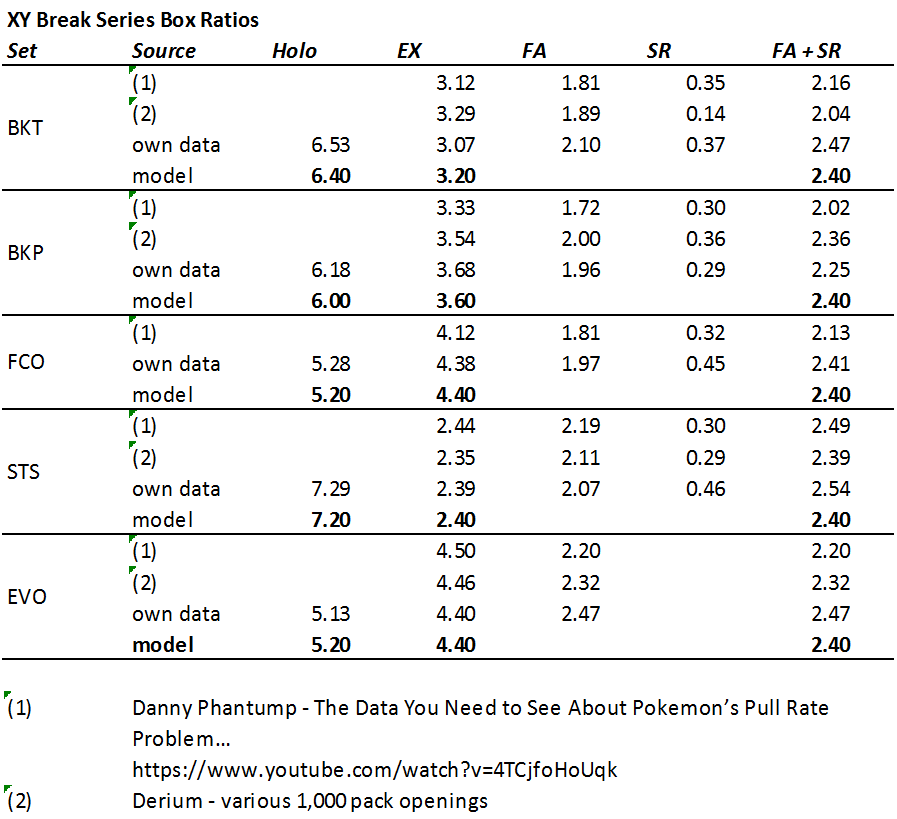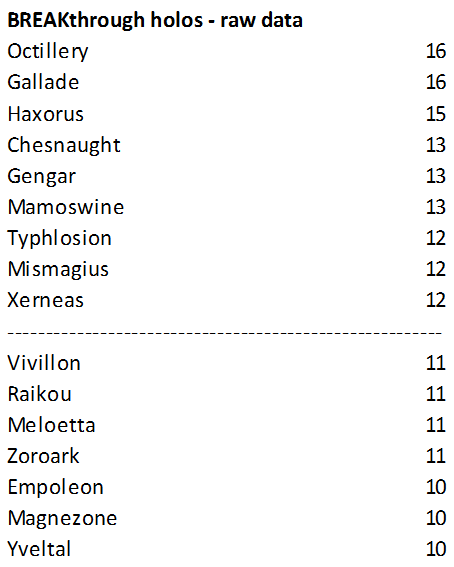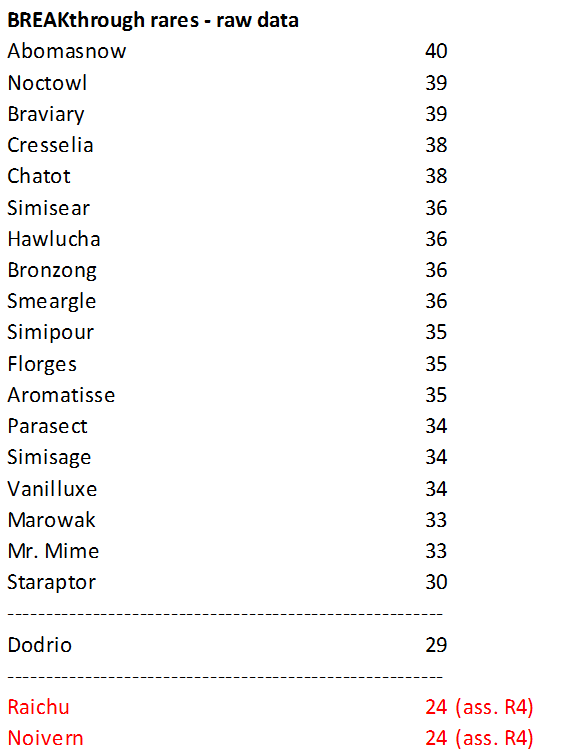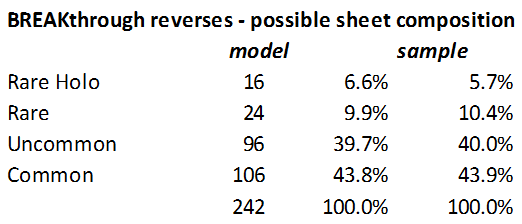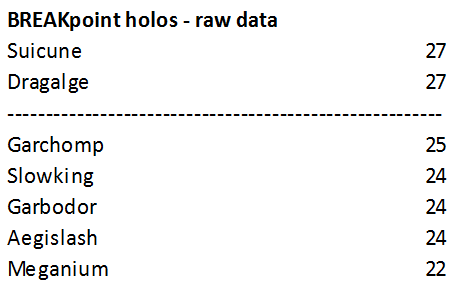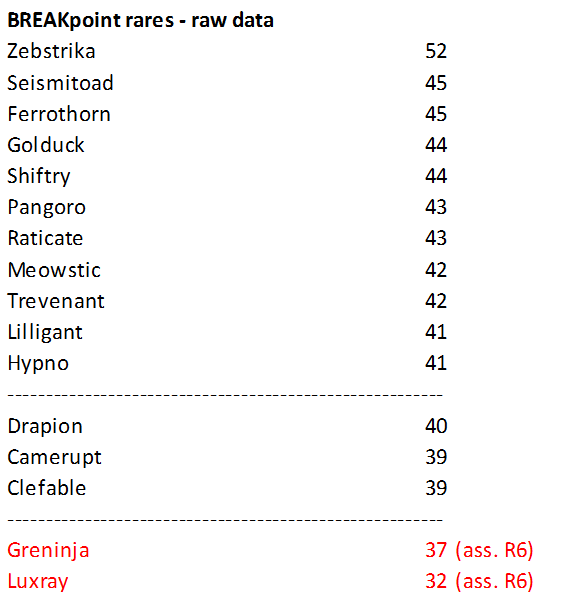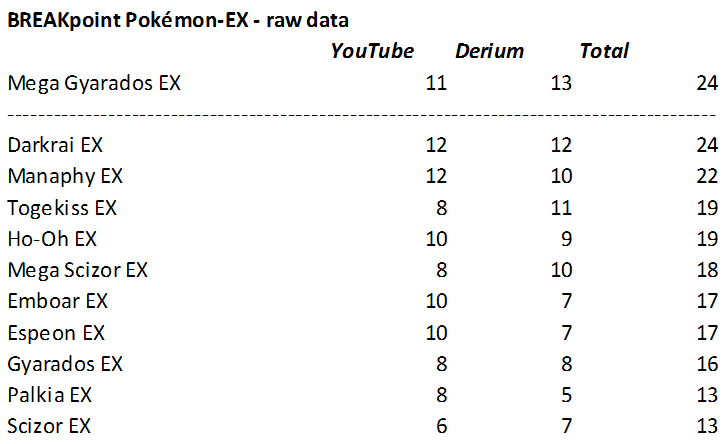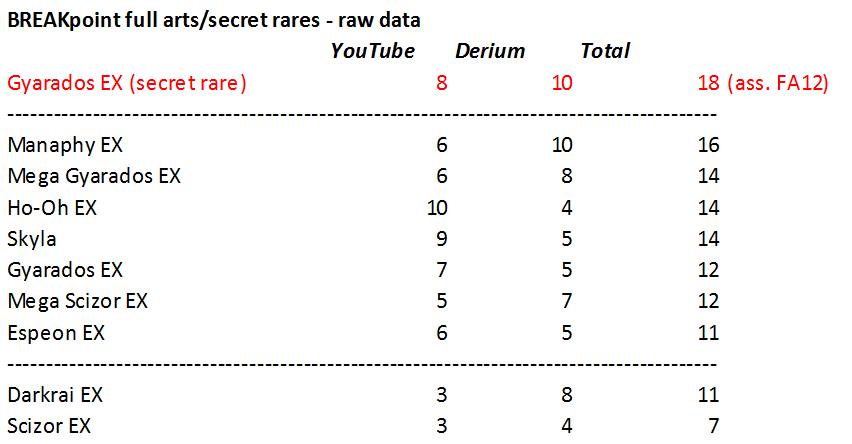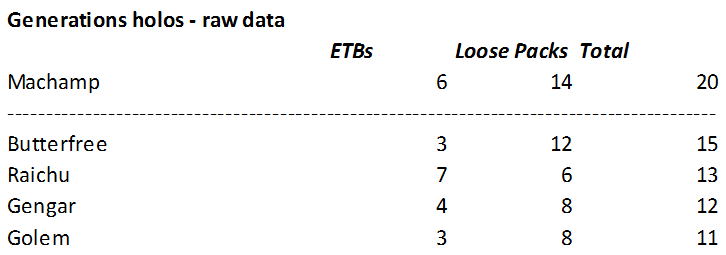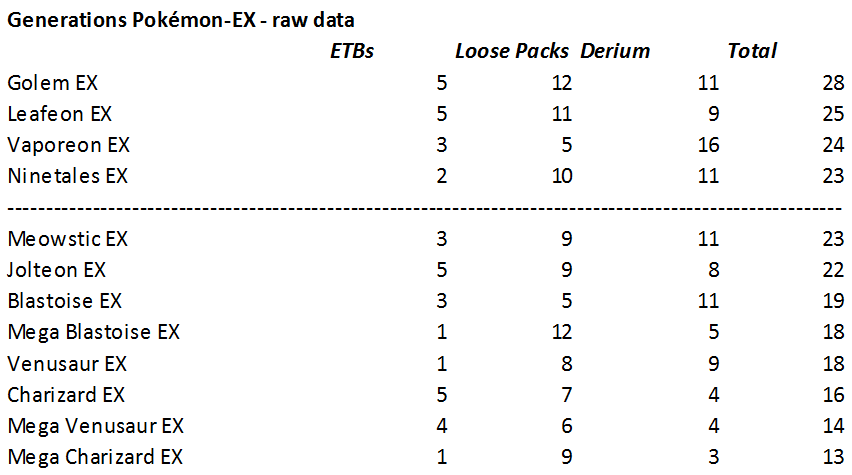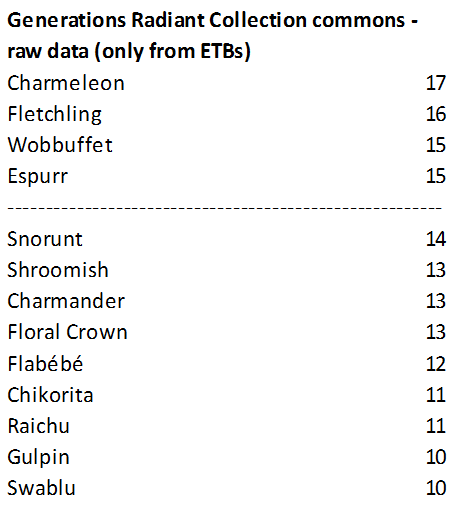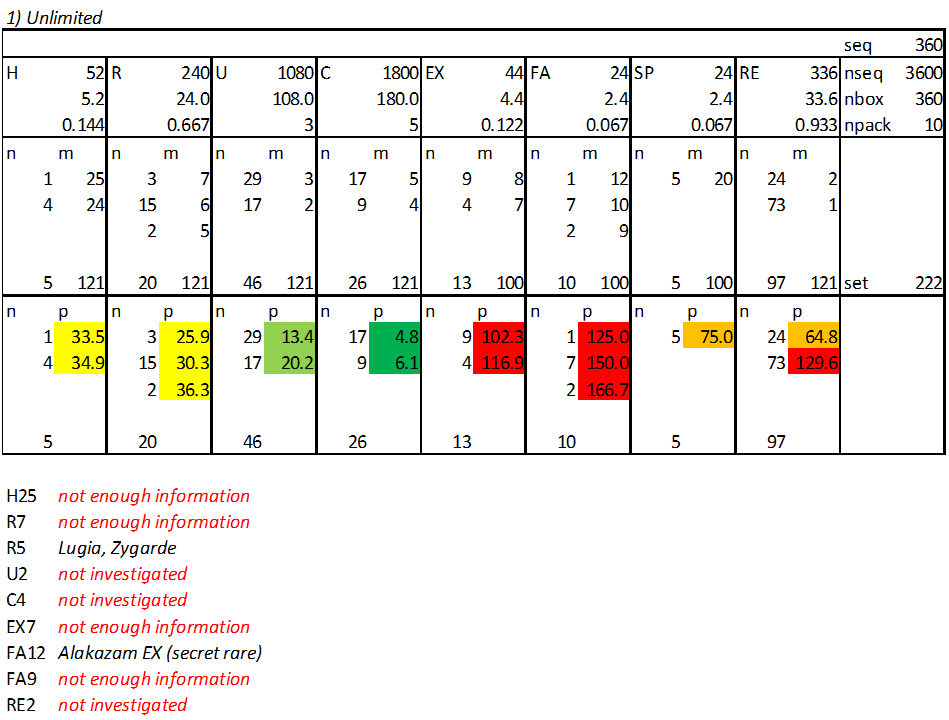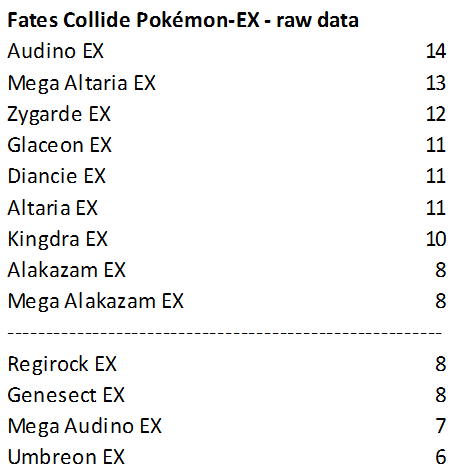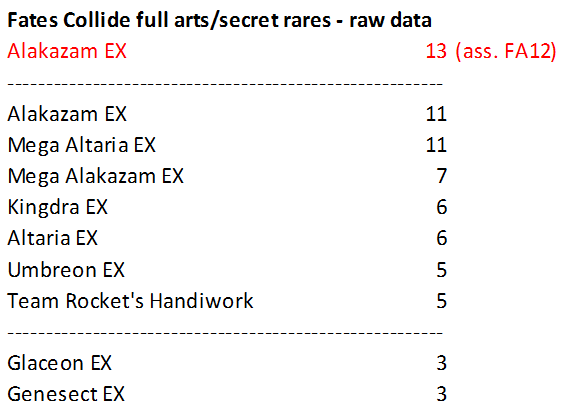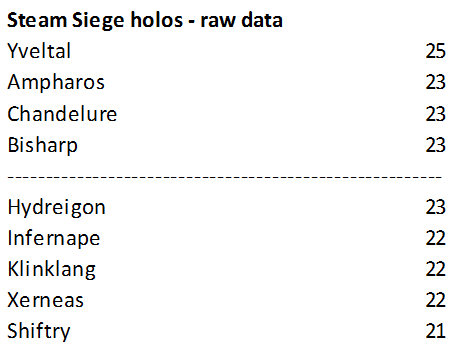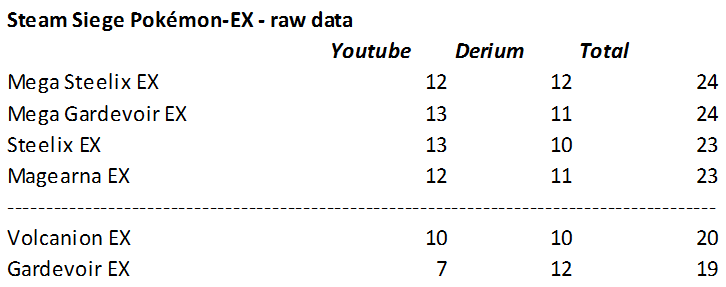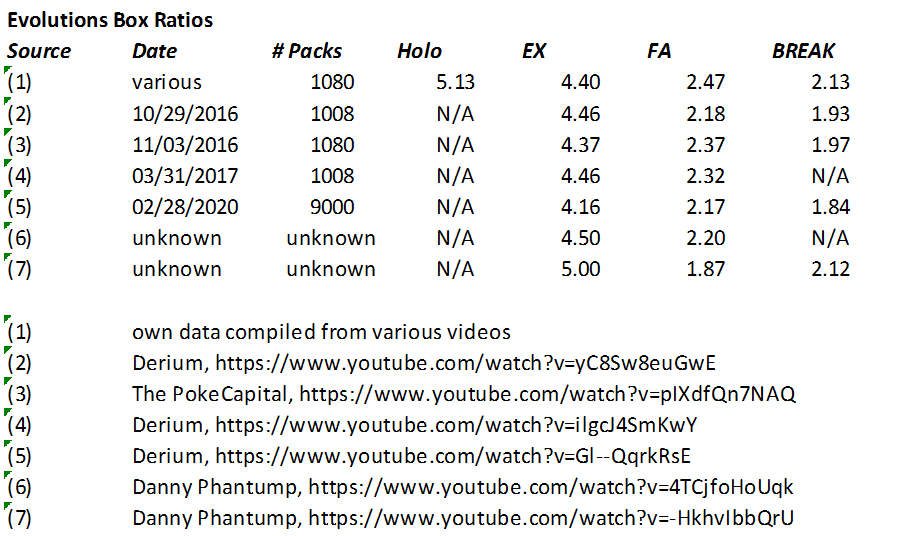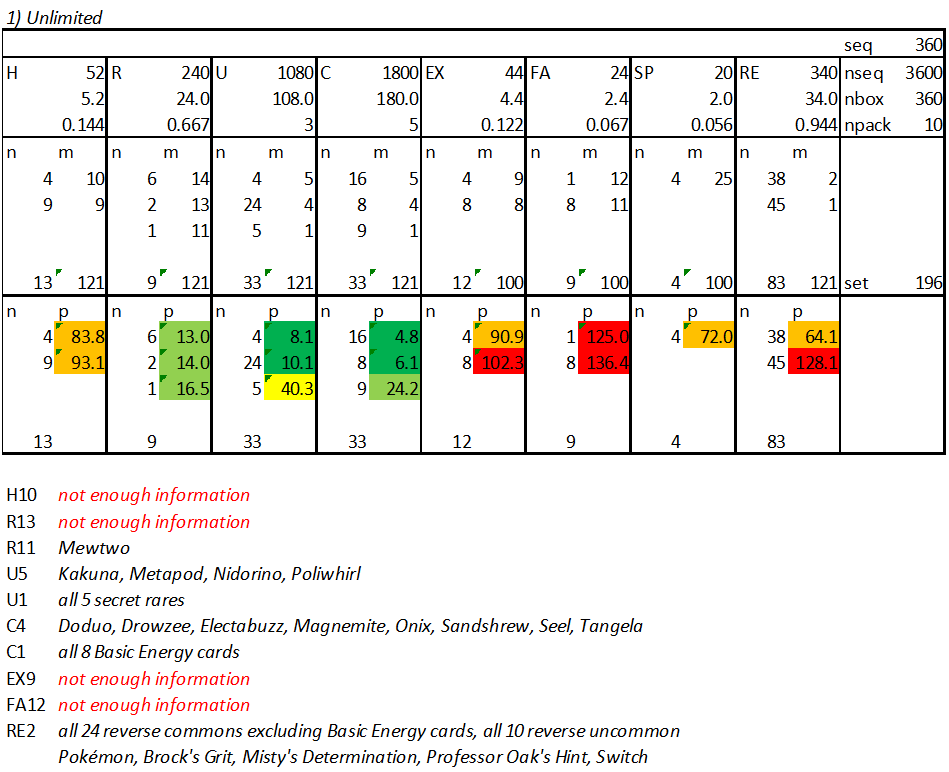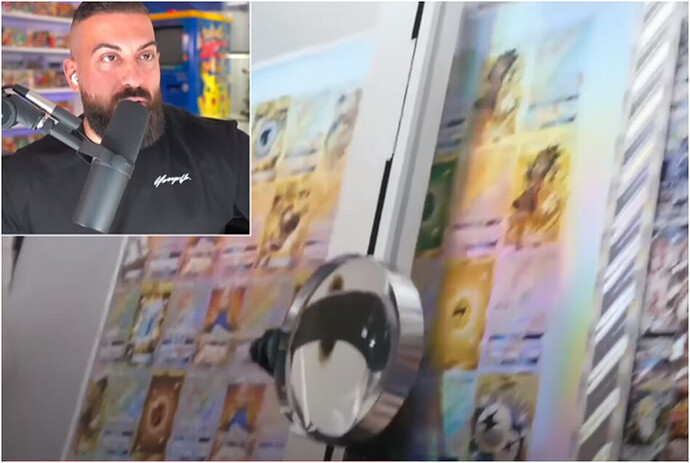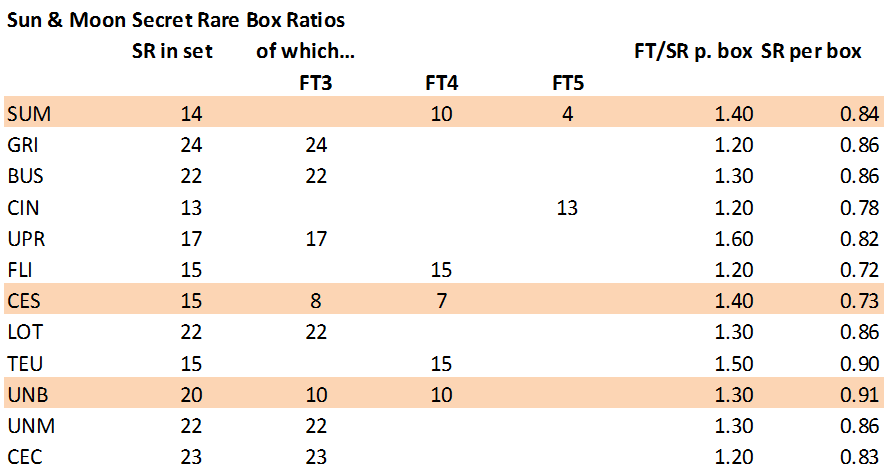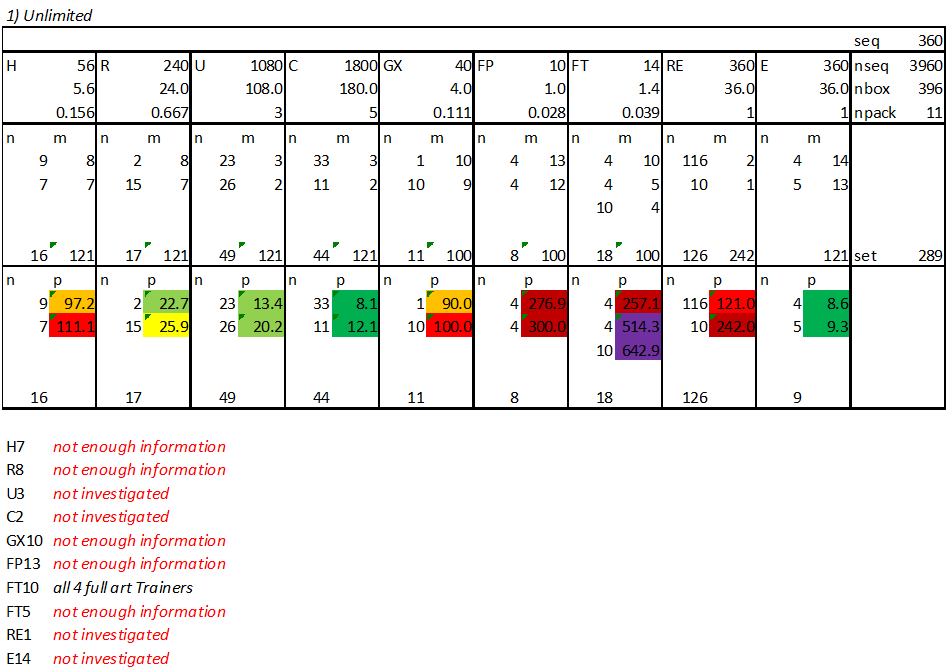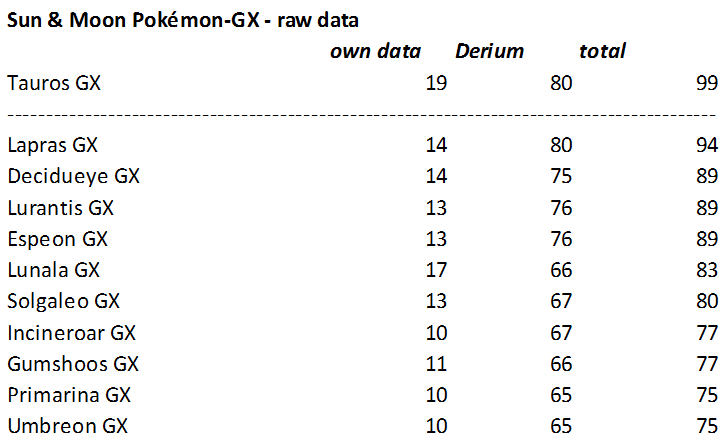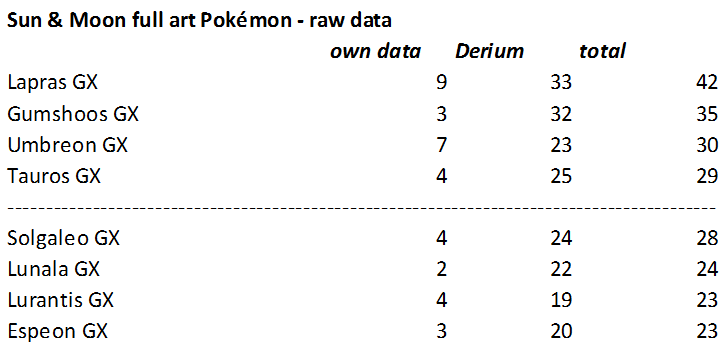Evolutions
Based on what I wrote earlier, in the model I am going with 4.4 “regular” Pokémon-EX, 2.4 full arts and 2.0 BREAK cards (the latter in the reverse slot) per box. I reconstructed the commons sheet (which has the 9 Basic Energy cards on it), the uncommons sheet (which has the 5 secret rares on it) and the reverses sheet. The rarity table for Evolutions looks as follows:
For the rares sheet, it appears from the raw data (see below) that Mewtwo, which features as a theme deck exclusive holo, is slightly rarer than the others; based on the raw data my guess is it is a R11 card, but that is somewhat uncertain. (The other theme deck exclusive holo is Pikachu; it is a C5 common.) The raw data for the holos and rares is as follows, the dashed lines indicating where the transition from H10 to H9, etc., would occur:
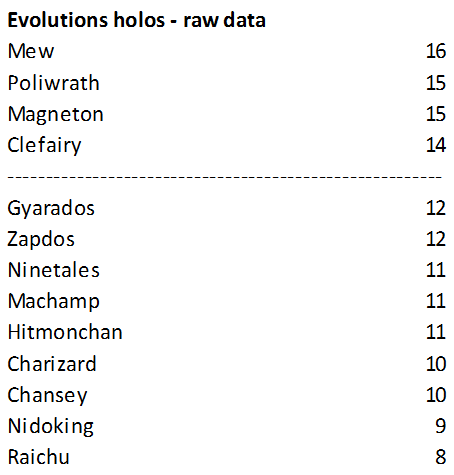
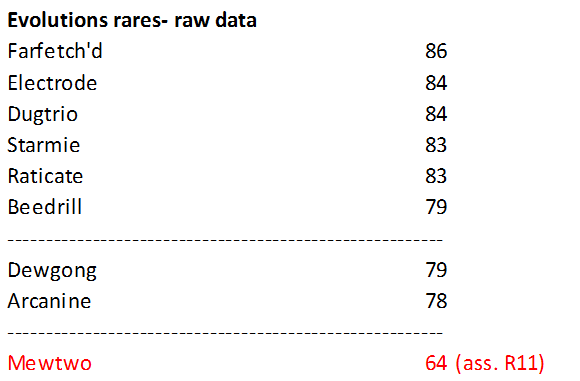
Thanks to the large openings on Youtube mentioned in the last post, I have a lot of data on the Pokémon-EX, full arts and BREAK cards coming from the recap of these videos which greatly exceeds the sample size I analyzed myself: 13,176 packs for the first two, and 12,168 for the BREAK cards. I am not breaking the data down between the five samples below, so here is the summary:
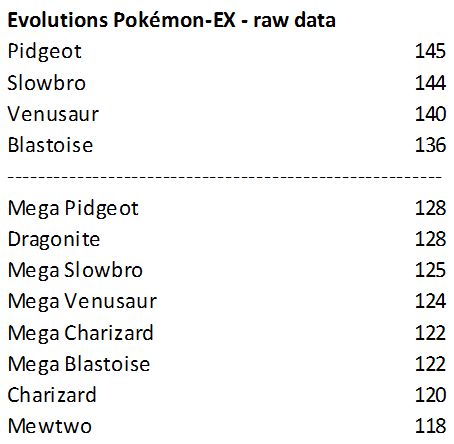
For the Pokémon-EX, Pidgeot EX, Slowbro EX, Venusaur EX and Blastoise EX are good candidates for the 4 EX9 cards, but I wouldn’t consider it to be completely certain.
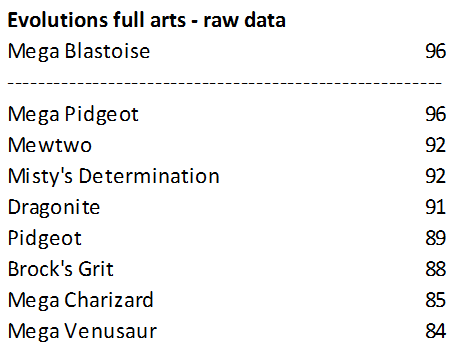

The data on BREAK cards is included for the sake of comparison with what according to the model at least should be the same rarity for all four cards.
As to the reconstructed sheets, the commons sheet looks as follows:
† Magnemite, Pikachu, Machop, Weedle, Doduo, Staryu, Onix, Fairy Energy, Voltorb, Tangela, Poliwag, Seel, Magikarp, Lightning Energy, Caterpie, Gastly, Diglett, Rattata, Charmander, Psychic Energy, Pikachu, Growlithe, Machop, Nidoran m, Ponyta, Drowzee, Electabuzz, Vulpix, Sandshrew, Onix, Magikarp, Fighting Energy, Staryu, Tangela, Rattata, Weedle, Voltorb, Poliwag, Gastly, Magnemite, Seel, Charmander, Diglett, Drowzee, Caterpie, Doduo, Pikachu, Machop, Growlithe, Onix, Nidoran m, Poliwag, Grass Energy, Rattata, Vulpix, Electabuzz, Magikarp, Gastly, Sandshrew, Weedle, Tangela, Ponyta, Doduo, Staryu, Seel, Charmander, Magnemite, Water Energy, Growlithe, Machop, Voltorb, Diglett, Caterpie, Poliwag, Pikachu, Ponyta, Nidoran m, Vulpix, Darkness Energy, Magikarp, Weedle, Electabuzz, Drowzee, Staryu, Metal Energy, Growlithe, Gastly, Charmander, Rattata, Caterpie, Magnemite, Voltorb, Sandshrew, Poliwag, Diglett, Seel, Nidoran m, Ponyta, Doduo, Pikachu, Staryu, Onix, Weedle, Machop, Tangela, Vulpix, Fire Energy, Voltorb, Charmander, Diglett, Gastly, Caterpie, Drowzee, Magikarp, Electabuzz, Rattata, Growlithe, Nidoran m, Vulpix, Sandshrew, Ponyta †
The reverses sheet looks as follows:
† Kakuna, Misty’s Determination, Porygon, Fire Energy, Gastly, Devolution Spray, Doduo, Switch, Poliwag, Charizard, Tangela, Nidorino, Pidgeot Spirit Link, Pikachu, Water Energy, Zapdos, Energy Retrieval, Brock’s Grit, Onix, Drowzee, Ninetales, Professor Oak’s Hint, Rattata, Pokédex, Staryu, Lightning Energy, Nidoking, Full Heal, Vulpix, Venusaur Spirit Link, Seel, Poliwrath, Chansey, Ponyta, Potion, Voltorb, Psychic Energy, Mew, Maintenance, Charmander, Double Colorless Energy, Diglett, Gyarados, Beedrill, Switch, Machop, Haunter, Fighting Energy, Machamp, Magnemite, Charmeleon, Nidoran m, Sandshrew, Raichu, Arcanine, Growlithe, Metapod, Machoke, Darkness Energy, Hitmonchan, Magikarp, Onix, Poliwhirl, Caterpie, Magneton, Dewgong, Gastly, Magmar, Misty’s Determination, Metal Energy, Clefairy, Revive, Poliwag, Mewtwo, Koffing, Doduo, Starmie, Professor Oak’s Hint, Pikachu, Kakuna, Fairy Energy, Porygon, Slowbro Spirit Link, Electabuzz, Dugtrio, Drowzee, Brock’s Grit, Electrode, Staryu, Rattata, Vulpix, Poliwhirl, Machoke, Super Potion, Charmander, Raticate, Nidorino, Ponyta, Weedle, Voltorb, Sandshrew, Seel, Haunter, Blastoise Spirit Link, Tangela, Machop, Farfetch’d, Nidoran m, Charmeleon, Magmar, Weedle, Diglett, Growlithe, Grass Energy, Koffing, Charizard Spirit Link, Caterpie, Metapod, Magikarp, Magnemite, Electabuzz †
The uncommons sheet look as follows (the secret rares are underlined):
† Misty’s Determination, Revive, Haunter, Brock’s Grit, Slowbro Spirit Link, Kakuna, Energy Retrieval, Blastoise Spirit Link, Switch, Nidorino, Pidgeot Spirit Link, Porygon, Full Heal, Poliwhirl, Pokédex, Potion, Magmar, Venusaur Spirit Link, Metapod, Charizard Spirit Link, Double Colorless Energy, Machoke, Koffing, Kakuna, Charmeleon, Professor Oak’s Hint, Nidorino, Super Potion, Brock’s Grit, Maintenance, Switch, Magmar, Devolution Spray, Pokédex, Porygon, Pidgeot Spirit Link, Metapod, Imakuni’s Doduo, Haunter, Blastoise Spirit Link, Misty’s Determination, Poliwhirl, Revive, Slowbro Spirit Link, Super Potion, Charmeleon, Venusaur Spirit Link, Energy Retrieval, Nidorino, Double Colorless Energy, Charizard Spirit Link, Kakuna, Full Heal, Machoke, Potion, Maintenance, Poliwhirl, Brock’s Grit, Professor Oak’s Hint, Metapod, Switch, Koffing, Revive, Here Comes Team Rocket!, Magmar, Surfing Pikachu, Misty’s Determination, Porygon, Devolution Spray, Nidorino, Slowbro Spirit Link, Pokédex, Haunter, Energy Retrieval, Kakuna, Pidgeot Spirit Link, Blastoise Spirit Link, Switch, Machoke, Full Heal, Venusaur Spirit Link, Potion, Metapod, Professor Oak’s Hint, Double Colorless Energy, Super Potion, Charmeleon, Charizard Spirit Link, Poliwhirl, Maintenance, Haunter, Flying Pikachu, Koffing, Misty’s Determination, Revive, Nidorino, Devolution Spray, Brock’s Grit, Slowbro Spirit Link, Magmar, Energy Retrieval, Blastoise Spirit Link, Pidgeot Spirit Link, Poliwhirl, Full Heal, Porygon, Pokédex, Kakuna, Potion, Venusaur Spirit Link, Machoke, Super Potion, Charizard Spirit Link, Charmeleon, Double Colorless Energy, Devolution Spray, Metapod, Professor Oak’s Hint, Koffing, Maintenance, Exeggutor †
Note that due to the proximity of Here Comes Team Rocket! and Surfing Pikachu, it is possible to get two secret rares in one pack.
Also, note that the sheet contains a handful of repeated sequences of two cards. That means that looking at the individual packs alone, it would not be possible to reconstruct the complete sheet (for example, it would not be possible to tell if the sequence Kakuna - Energy Retrieval - Blastoise Spirit Link is followed by Switch or by Pidgeot Spirit Link). It is possible to look at the sequence the packs come in a box, though, and that allowed me to reconstruct the complete sheet rather easily. I may make a special post on how exactly I did this in the future.
This concludes the XY series. The next step for the Sun & Moon series will be determining which box ratios to use in my model based on the data I have compiled, and based on large opening videos on Youtube like the ones I used for analyzing recent sets.
Edit 2024/03/23: Added reconstruction of complete uncommons sheet.
Edit 2024/03/24: Changed sequence length from 180 to 360. This has no impact on pull rates.
